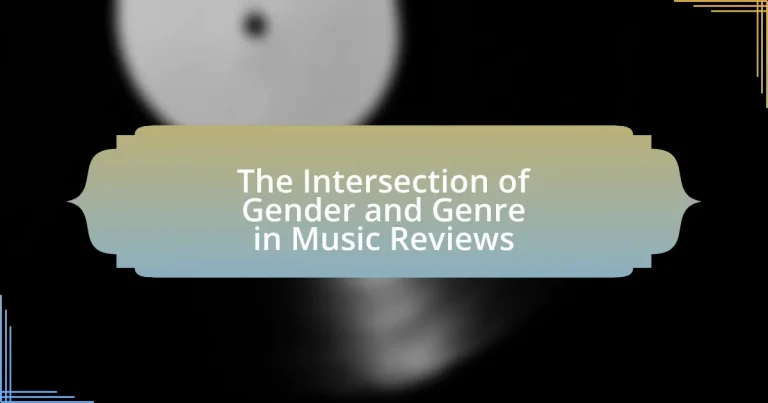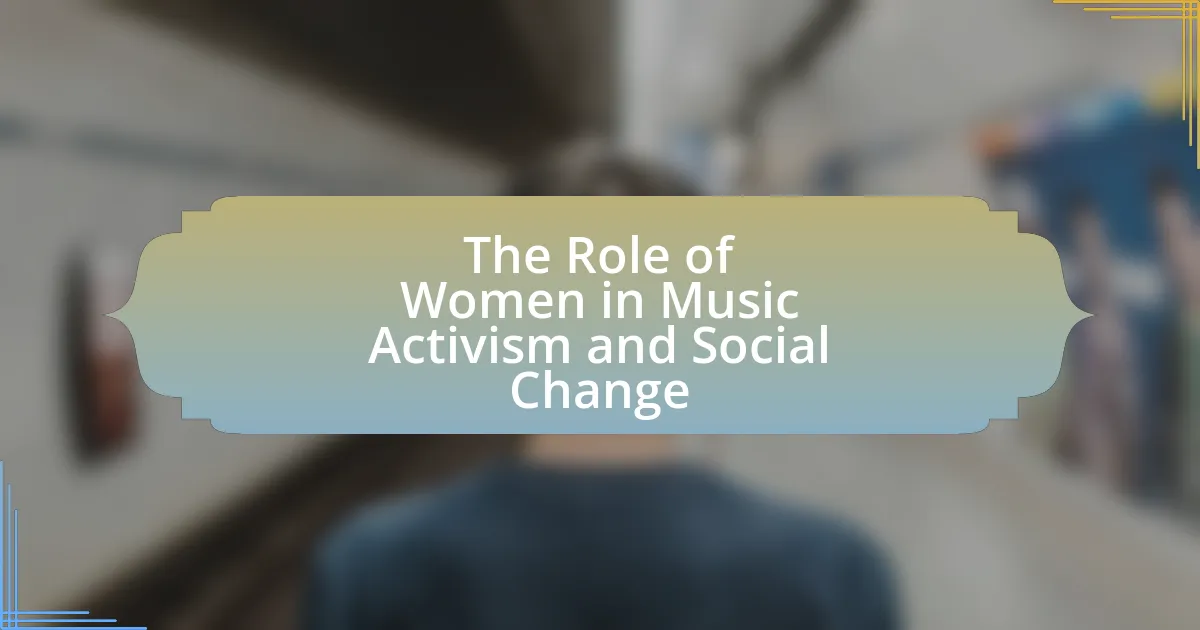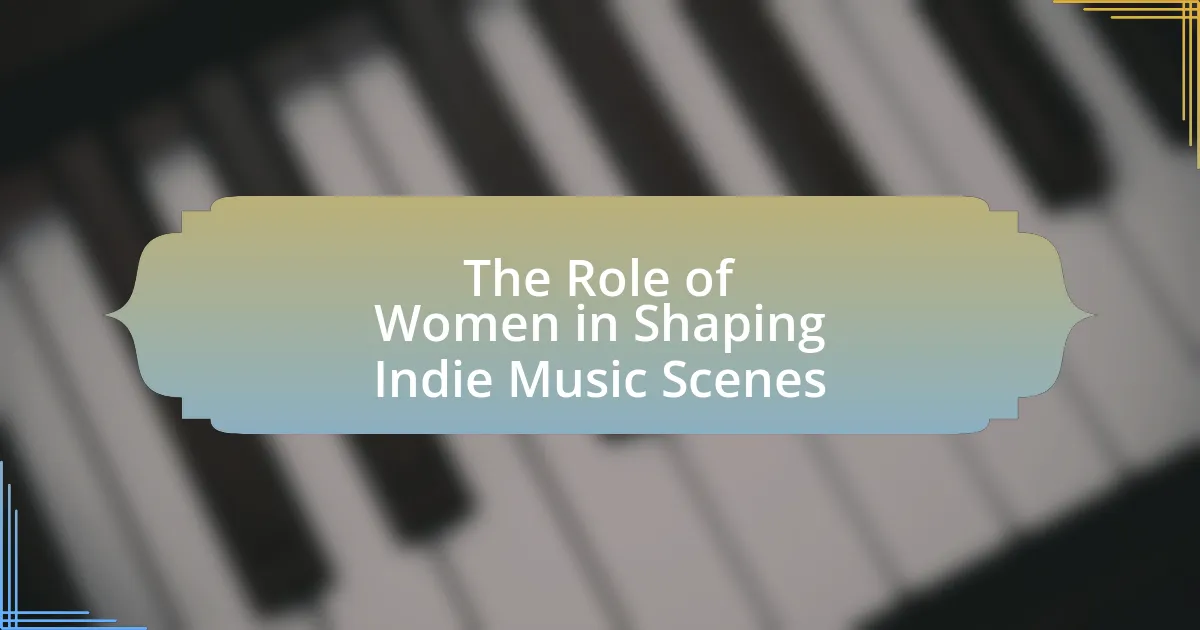The article examines the intersection of gender and genre in music reviews, highlighting how the identities of reviewers and the genres they critique influence music interpretation and reception. It discusses the differing perspectives and biases of male and female critics, particularly how female artists often face harsher criticism in male-dominated genres like rock and hip-hop. Key themes include representation, stereotyping, and the impact of gender on artistic interpretation, as well as the historical context of gender biases in music criticism. The article emphasizes the importance of analyzing these dynamics to foster inclusivity and challenge existing biases in the music industry.
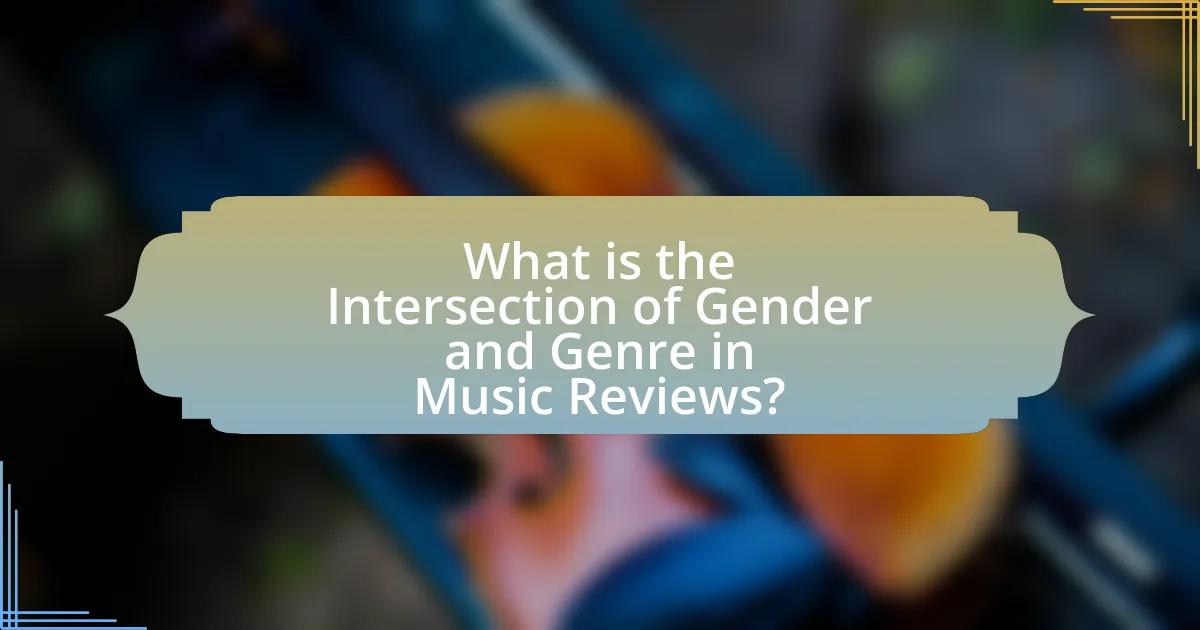
What is the Intersection of Gender and Genre in Music Reviews?
The intersection of gender and genre in music reviews refers to how the identities of reviewers and the genres they critique influence the interpretation and reception of music. Research indicates that male and female reviewers often have different perspectives and biases, which can affect their evaluations of artists based on gender stereotypes associated with specific genres. For instance, studies show that female artists in rock or hip-hop may receive harsher criticism compared to their male counterparts, reflecting societal biases. Additionally, genre conventions can shape expectations around gender performance, leading to varied interpretations of the same work depending on the reviewer’s gender identity. This dynamic highlights the importance of considering both gender and genre in understanding music criticism and its implications for artists and audiences alike.
How do gender and genre influence music review perspectives?
Gender and genre significantly influence music review perspectives by shaping the expectations and biases of both reviewers and audiences. Research indicates that male and female critics often have differing interpretations and evaluations of music, influenced by societal norms and personal experiences. For instance, studies show that female artists may be judged more harshly in genres traditionally dominated by men, such as rock or hip-hop, leading to a disparity in how their work is perceived compared to male counterparts. Additionally, genre conventions can dictate the language and criteria used in reviews, with certain genres receiving more lenient or stringent critiques based on prevailing stereotypes. This intersection creates a complex landscape where gender biases and genre expectations intertwine, ultimately affecting the reception and interpretation of music.
What are the key gender-related themes in music reviews?
Key gender-related themes in music reviews include representation, stereotyping, and the impact of gender on artistic interpretation. Representation focuses on how male and female artists are portrayed differently, often highlighting the underrepresentation of women in certain genres. Stereotyping examines how gender norms influence the perception of artists, with women frequently being judged on appearance rather than musical talent. The impact of gender on artistic interpretation reveals how critics may interpret music differently based on the artist’s gender, affecting the reception of their work. These themes are supported by studies indicating that female artists often receive less favorable reviews compared to their male counterparts, reflecting broader societal biases in the music industry.
How does genre shape the expectations of music critics?
Genre significantly shapes the expectations of music critics by establishing a framework of stylistic norms and conventions that inform their evaluations. Critics often rely on genre-specific criteria, such as instrumentation, lyrical themes, and production techniques, to assess the quality and authenticity of a musical work. For instance, a rock album is typically expected to feature electric guitars and a certain level of raw energy, while a classical piece is judged based on its adherence to compositional structures and orchestration. This genre-based lens can lead to biases, as critics may favor works that conform to established norms over those that innovate or blend genres. Research indicates that critics’ reviews often reflect these genre expectations, influencing public perception and reception of the music, as seen in studies analyzing the correlation between genre classification and critical acclaim.
Why is it important to analyze gender and genre in music reviews?
Analyzing gender and genre in music reviews is important because it reveals how societal norms and expectations shape musical expression and reception. Gender influences the way artists are perceived, often leading to biases in reviews that can affect an artist’s career trajectory. For instance, research shows that female artists frequently receive less favorable reviews compared to their male counterparts, regardless of the quality of their work. Additionally, genre categorization can reinforce stereotypes; for example, certain genres may be associated with specific genders, impacting the diversity of voices represented in music criticism. Understanding these dynamics allows for a more equitable and comprehensive evaluation of music, fostering inclusivity and challenging existing biases in the industry.
What impact does gender representation have on music criticism?
Gender representation significantly influences music criticism by shaping the perspectives and biases present in reviews. Critics’ gender can affect the interpretation of music, often leading to gendered evaluations where male artists receive more favorable assessments compared to female artists. Research indicates that female musicians are frequently critiqued based on their appearance or personal life rather than their musical talent, which reflects broader societal biases. For instance, a study published in the Journal of Popular Music Studies found that female artists are often described in terms of their relationships, while male artists are evaluated based on their musical achievements. This disparity in representation can perpetuate stereotypes and limit the visibility of diverse voices in the music industry.
How does genre classification affect the reception of music reviews?
Genre classification significantly influences the reception of music reviews by shaping listener expectations and critical perspectives. When a review categorizes music within a specific genre, it sets a framework for evaluation based on established conventions and norms associated with that genre. For instance, a pop album may be judged on its catchiness and commercial appeal, while a jazz album might be assessed for its improvisational complexity and musicianship. Research indicates that genre labels can lead to biases in how critics perceive and articulate their reviews, often favoring works that align with their personal genre preferences. This phenomenon can result in disparities in the reception of music across different genres, as critics may apply varying standards based on genre expectations, ultimately affecting the artist’s visibility and audience engagement.
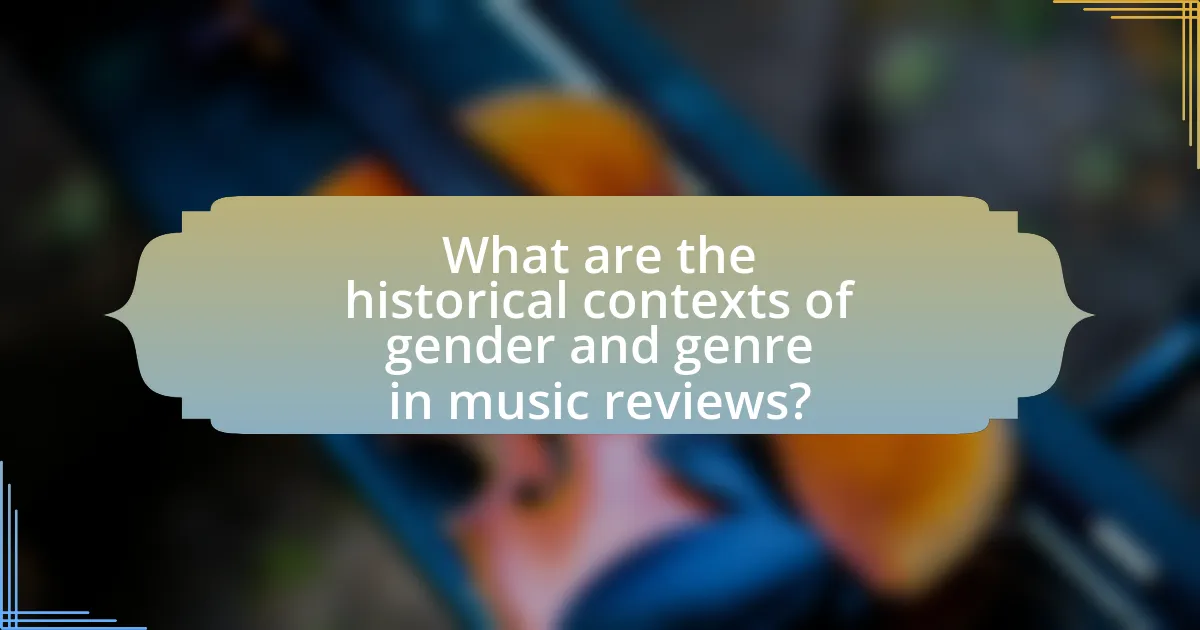
What are the historical contexts of gender and genre in music reviews?
The historical contexts of gender and genre in music reviews reveal significant patterns of bias and representation that have evolved over time. In the early 20th century, music criticism was predominantly male-dominated, often marginalizing female artists and reinforcing gender stereotypes; for instance, women were frequently categorized within genres like pop or jazz, while men were associated with rock or classical, which were deemed more prestigious. This gendered genre classification persisted through the decades, as seen in the 1970s and 1980s when feminist movements began challenging these norms, leading to a gradual increase in the visibility of female musicians and critics. Research by authors such as Susan McClary highlights how music reviews often reflect societal attitudes towards gender, with male critics historically favoring male artists, thus shaping public perception and genre legitimacy. This context underscores the ongoing struggle for equitable representation in music criticism, where gender biases continue to influence genre categorization and the reception of artists.
How have music reviews evolved in relation to gender and genre?
Music reviews have evolved significantly in relation to gender and genre, reflecting broader societal changes and shifts in cultural discourse. Historically, music criticism was predominantly male-dominated, often marginalizing female artists and perspectives. However, recent trends show an increase in female critics and a more inclusive approach to reviewing music across various genres, leading to a richer and more diverse representation of voices. For instance, studies indicate that the rise of social media has empowered women and marginalized groups to share their opinions, resulting in a more balanced discourse in music reviews. Additionally, the intersectionality of gender and genre has become a focal point, with critics increasingly analyzing how these factors influence the reception and interpretation of music, as seen in the growing recognition of women in genres like hip-hop and rock, which were traditionally male-centric.
What historical milestones have shaped gender representation in music criticism?
Historical milestones that have shaped gender representation in music criticism include the emergence of women critics in the late 19th and early 20th centuries, the feminist movements of the 1960s and 1970s, and the rise of digital platforms in the 21st century. The late 19th century saw figures like Janet Flanner and Virginia Woolf begin to challenge male-dominated narratives in music journalism. The feminist movements brought attention to gender biases, leading to increased visibility for women critics and artists. In the 21st century, the advent of online music criticism has democratized the field, allowing diverse voices, including those of women and non-binary individuals, to contribute significantly to music discourse. These milestones collectively reflect a gradual shift towards more equitable gender representation in music criticism.
How have genre definitions changed over time in music reviews?
Genre definitions in music reviews have evolved significantly over time, reflecting broader cultural shifts and the diversification of musical styles. Initially, genres were rigidly defined, often categorized by specific musical characteristics and cultural origins, such as rock, jazz, or classical. However, as music has become more hybridized, with artists blending elements from various genres, reviews have increasingly adopted more fluid definitions that recognize the complexity of contemporary music. For instance, the rise of genres like “indie pop” or “trap” illustrates how traditional boundaries have blurred, prompting reviewers to consider not just sound but also cultural context and audience reception. This shift is evidenced by the growing prevalence of genre-bending artists and the corresponding adaptation in music journalism, which now often emphasizes the intersectionality of genres and the influence of social factors, including gender, on musical expression and classification.
What role do cultural perceptions play in music reviews?
Cultural perceptions significantly influence music reviews by shaping critics’ interpretations and audience reception of musical works. These perceptions are informed by societal norms, values, and historical contexts, which can lead to biases in how different genres and artists are evaluated. For instance, research indicates that gender stereotypes often affect the way female artists are critiqued compared to their male counterparts, with women frequently facing harsher scrutiny regarding their musical abilities and image. This bias can skew public perception and impact the commercial success of artists, as seen in studies that highlight disparities in review scores based on gender. Thus, cultural perceptions play a crucial role in framing the narrative around music, affecting both critical analysis and listener engagement.
How do societal norms influence gender portrayals in music reviews?
Societal norms significantly influence gender portrayals in music reviews by shaping the expectations and stereotypes associated with different genders. These norms dictate how male and female artists are perceived, often leading to biased interpretations of their work. For instance, male musicians are frequently described using assertive and dominant language, while female musicians may be characterized in terms of their appearance or emotional expressiveness. Research by the University of Southern California found that women in music reviews are often portrayed in a more sexualized manner compared to their male counterparts, reinforcing traditional gender roles. This disparity highlights how societal expectations can skew the representation of artists based on gender, ultimately affecting public perception and reception of their music.
What cultural biases exist within genre-specific music criticism?
Cultural biases within genre-specific music criticism often manifest in the form of gender stereotypes, racial prejudices, and class assumptions. For instance, female artists in genres like rock or hip-hop frequently face scrutiny that emphasizes their appearance or personal lives rather than their musical talent, reflecting a gender bias that prioritizes male perspectives. Research by the Annenberg Inclusion Initiative found that only 22.4% of artists in popular music are women, indicating a systemic bias that influences how female musicians are critiqued compared to their male counterparts. Additionally, critics may favor certain genres associated with specific racial or cultural identities, leading to a lack of recognition for artists outside those norms. This bias can skew public perception and limit the diversity of voices celebrated in music criticism.
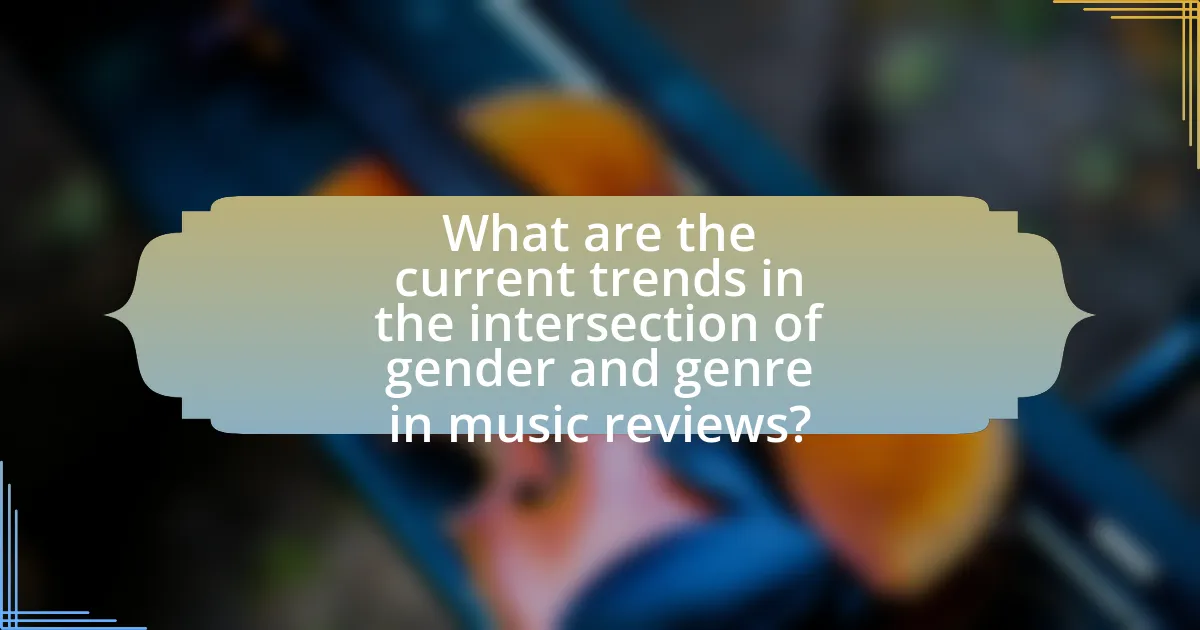
What are the current trends in the intersection of gender and genre in music reviews?
Current trends in the intersection of gender and genre in music reviews indicate a growing emphasis on inclusivity and representation. Music critics increasingly highlight the contributions of women and non-binary artists across various genres, challenging traditional gender norms. For instance, studies show that female artists are receiving more coverage in genres historically dominated by men, such as rock and hip-hop, reflecting a shift in critical perspectives. Additionally, the rise of intersectional feminism in music journalism has led to a more nuanced analysis of how gender interacts with race, sexuality, and class within musical contexts. This trend is supported by data from platforms like Pitchfork and Rolling Stone, which have expanded their focus on diverse voices in their reviews, showcasing a broader spectrum of gender identities and musical styles.
How are contemporary music critics addressing gender and genre issues?
Contemporary music critics are increasingly addressing gender and genre issues by analyzing how societal norms influence musical expression and reception. Critics highlight the ways in which gender biases affect the representation of artists across various genres, often emphasizing the underrepresentation of women and non-binary artists in mainstream music. For instance, studies have shown that female artists receive less coverage and recognition compared to their male counterparts, which critics actively challenge by advocating for equitable representation in reviews and discussions. Additionally, critics are exploring how genre classifications can perpetuate stereotypes, such as associating certain genres with specific genders, thereby limiting artistic expression. This critical examination is supported by data indicating that diverse voices in music lead to richer cultural narratives and broader audience engagement.
What innovative approaches are being taken in music reviews today?
Innovative approaches in music reviews today include the use of multimedia formats, such as video and interactive content, to enhance the listener’s experience. These formats allow reviewers to incorporate visual elements, audio samples, and real-time audience engagement, making the review more dynamic and accessible. For instance, platforms like YouTube and TikTok have become popular for music critiques, where reviewers can showcase snippets of songs alongside their commentary, thus reaching a broader audience. Additionally, data analytics tools are being utilized to analyze listener trends and preferences, providing a more informed basis for reviews. This shift towards a more interactive and data-driven approach reflects the evolving landscape of music consumption and the need for reviews to adapt to new media consumption habits.
How are social media and digital platforms influencing music criticism?
Social media and digital platforms are significantly influencing music criticism by democratizing the review process and amplifying diverse voices. These platforms allow users to share their opinions instantly, leading to a more varied landscape of music critique that includes perspectives from traditionally underrepresented groups. For instance, research by the Pew Research Center indicates that 72% of adults use social media, which facilitates the rapid dissemination of music reviews and encourages engagement from a broader audience. This shift has resulted in a more inclusive dialogue around music, where gender and genre intersections are increasingly highlighted, allowing critics from different backgrounds to contribute to the conversation and challenge mainstream narratives.
What challenges do critics face when discussing gender and genre?
Critics face significant challenges when discussing gender and genre due to the complexities of societal norms and biases that influence perceptions. These challenges include the risk of reinforcing stereotypes, as critics may inadvertently apply gendered expectations to musical genres, which can limit the understanding of an artist’s work. For instance, the association of certain genres with specific genders can lead to misinterpretations of an artist’s intent or the cultural significance of their music. Additionally, critics often grapple with the lack of diverse representation within both the music industry and critical discourse, which can skew perspectives and diminish the voices of marginalized artists. This issue is compounded by the evolving nature of gender identity, making it difficult for critics to categorize artists within traditional genre frameworks without oversimplifying their contributions.
What biases might affect the objectivity of music reviews?
Biases that might affect the objectivity of music reviews include personal preferences, cultural biases, and gender biases. Personal preferences can lead reviewers to favor certain genres or artists based on their own tastes, which skews the evaluation process. Cultural biases may arise when reviewers apply their own cultural standards to music from different backgrounds, potentially misinterpreting or undervaluing the work. Gender biases can manifest in the way male and female artists are perceived and critiqued, with studies indicating that female artists often receive less favorable reviews compared to their male counterparts, regardless of the quality of their music. For instance, research published in the journal “Popular Music” highlights that female musicians are frequently judged more harshly on technical aspects than male musicians, illustrating the impact of gender bias on music reviews.
How can critics navigate the complexities of gender and genre in their analyses?
Critics can navigate the complexities of gender and genre in their analyses by employing an intersectional framework that considers how these elements interact within cultural contexts. This approach allows critics to recognize that gender identities and genre conventions are not fixed but are influenced by social, historical, and political factors. For instance, studies have shown that music genres often carry gendered expectations, which can shape both the creation and reception of music. By analyzing how artists subvert or conform to these expectations, critics can provide deeper insights into the work’s meaning and impact. Additionally, incorporating diverse perspectives, including those from marginalized voices, enhances the richness of the analysis and acknowledges the multifaceted nature of both gender and genre in music.
What best practices can enhance the analysis of gender and genre in music reviews?
To enhance the analysis of gender and genre in music reviews, employing intersectional frameworks is essential. Intersectionality allows for a nuanced understanding of how gender and genre interact, revealing the complexities of identity in music. For instance, analyzing how female artists are often categorized within specific genres, such as pop or country, can highlight systemic biases in the music industry. Research by Sarah Raine in “Gender and Genre in Popular Music” (2019) demonstrates that female musicians frequently face genre constraints that male counterparts do not, affecting their representation and reception. Additionally, utilizing qualitative methods, such as interviews and focus groups, can provide deeper insights into artists’ experiences and audience perceptions, further enriching the analysis.
How can critics ensure a balanced representation of gender in their reviews?
Critics can ensure a balanced representation of gender in their reviews by actively seeking diverse perspectives and voices in the music they critique. This involves including works from female artists and non-binary musicians alongside their male counterparts, thereby reflecting a broader spectrum of gender representation in the music industry. Research indicates that female artists are often underrepresented in music reviews, with studies showing that only 22% of music reviews feature female artists prominently. By consciously highlighting and promoting gender diversity in their selections, critics can contribute to a more equitable representation in music discourse.
What strategies can be employed to critically engage with genre in music reviews?
To critically engage with genre in music reviews, one effective strategy is to analyze the historical and cultural context of the genre being reviewed. This involves examining how the genre has evolved over time and its socio-political implications, which can provide deeper insights into the music’s significance. For instance, understanding the roots of hip-hop in the African American community during the 1970s can illuminate its themes of resistance and identity. Additionally, employing comparative analysis with other genres can highlight unique characteristics and influences, such as how punk rock’s DIY ethos contrasts with mainstream pop. This approach not only enriches the review but also fosters a more nuanced understanding of the music’s place within broader cultural narratives.
